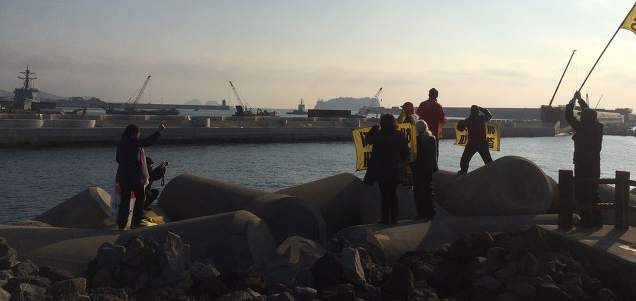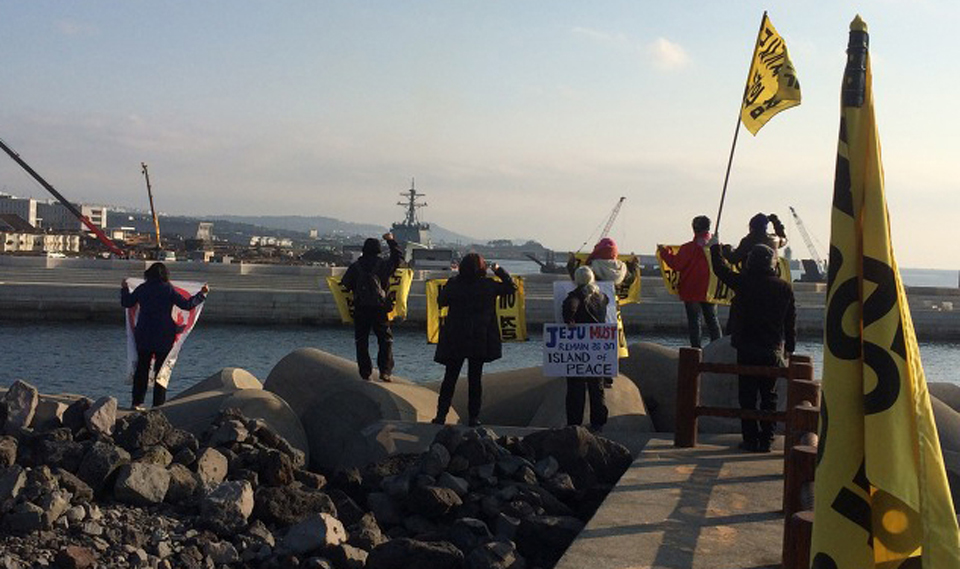
‘Around 9 am, [Dec. 22, 2015], the 7th task flotilla command department including Navy R. Adm Nam Dong-woo, chief of the Navy’s 7th Task Flotilla, arrived in the [currently built] Jeju naval base which would be its new home port, having left Busan Naval Operational Command on Dec. 21, riding on the two 7,600 ton Aegis Destroyers of the Sejong, the Great and Yulgok Yi Yi, and one 4,400 ton Aegis Destroyer of Munmu the Great. . On Dec. 22, the 7th task flotilla, installing the troops’ signboard on the main gate of the [inside of the not-yet-completed] Jeju naval base, had the ceremony on the task flotilla’s relocation to Jeju in the military training ground there.’ (Yonhap news, Dec. 22, translated form Korean article)
‘On Dec. 20, the 93rd submarine squadron( its chief is captain Choi Ki-Young) under the submarine headquarter that carries out underwater operation, moved itself riding on the landing ship (ROK LST) to the [not-yet-completed] Jeju naval base.’ (same as the above)
‘The 7th task flotilla created on Feb. 1, 2010 is composed of Sejong, the Great class aegis destroyers((7,600t, DDG), Chungmugong Yi Sun-sin-class aegis destroyer(4,400t, DDH-II). It carries out the duties of support for the nation’s foreign policy, such as sea lane protection, military readiness posture against North Korea, and dispatch of Chunghae troop unit etc.’ (same as the above)
(Related Yonhap photo links: 1, 2, 3 )
Once arrived in the port, we could see an ugly aegis destroyer being moored while another aegis destroyer coming around very close to the Tiger Island, the UNESCO-designated along with its nearby sea. We shouted out, “No Need of Task Flotilla in the Peace Island! Go away, Aegis!” A giant group of birds flew in the sky, as if they felt something dangerous over the sea. The sea looked crying as 70 years before when the Island was blooded by the April 3rd incident.

Bruce Gagnon writes in his blog, as the below:
The Aegis missile defense program is a key element in Pentagon first-strike attack planning. Their role is to take out any retaliatory strikes after the US hits China or Russia. The closer the US can get these systems to China or Russia the better chance they have of working in a war time scenario. These are destabilizing systems and used to be illegal under the Anti-Ballistic Missile (ABM) Treaty with Russia until George W. Bush pulled the US out of the agreement soon after taking office. (See the whole writing, here)
We are now witnessing once a pristine UNESCO-designated Jeju Sea to become a horrible stage for the missile defense (offense) system, a key for the aggressive ROK-US-Japan trilateral military alliance.
The tasks of demilitarizing Jeju Island and to realizing the Sea of Peace is more urgent than ever. As Bishop Kang U-Il said, “Our real struggle starts from now on.”
